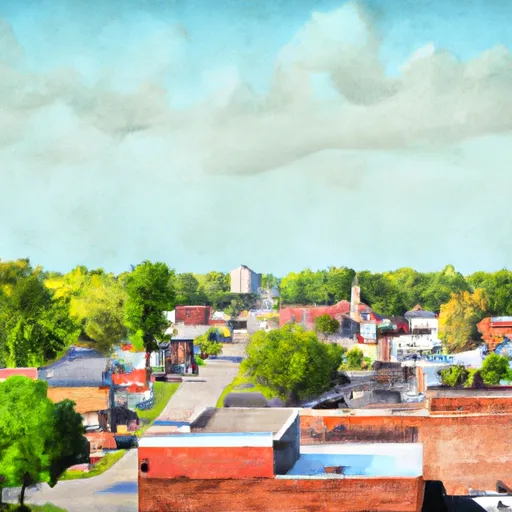-
 Snoflo Premium
Snoflo Premium
Get unlimited access to all our content
With no Ad interruptions! - Start Your Free Trial Login with existing account
Springville
Eden Index
Climate
8.1
•
Recreation
3.4
•
Community
0.8
•
Safeguard
4.6/10

Springville, Indiana is a small town located in Lawrence County with a population of approximately 4,500 residents. The town experiences a humid continental climate, characterized by hot summers and cold winters. Average temperatures range from 20°F (-6°C) in winter to 85°F (29°C) in summer. Precipitation is evenly distributed throughout the year, with an average annual rainfall of about 45 inches.
Hydrology in Springville is mainly influenced by the East Fork White River, which flows nearby. This river provides opportunities for recreational activities such as fishing, boating, and kayaking. The river is known for its diverse fish population, including bass, catfish, and sunfish.
In addition to the river, Springville boasts various outdoor recreation opportunities. The town is surrounded by beautiful natural landscapes, making it an ideal destination for hiking, camping, and birdwatching. The nearby Hoosier National Forest offers extensive trails for outdoor enthusiasts, allowing visitors to explore the stunning scenery and observe wildlife.
Overall, Springville, Indiana offers a pleasant climate, diverse hydrology constituents through the East Fork White River, and ample outdoor recreation opportunities for nature lovers and adventure seekers.
What is the Eden Index?
The Snoflo Eden Index serves as a comprehensive rating system for regions, evaluating their desirability through a holistic assessment of climate health, outdoor recreation opportunities, and natural disaster risk, acknowledging the profound impact of these factors on livability and well-being.
Climate Health Indicator (CHI): 8.1
Springville receives approximately
1201mm of rain per year,
with humidity levels near 83%
and air temperatures averaging around
13°C.
Springville has a plant hardyness factor of
6, meaning
plants and agriculture in this region thrive during a short period during spring and early summer. Most
plants will die off during the colder winter months.
By considering the ideal temperature range, reliable water supplies, clean air, and stable seasonal rain or snowpacks, the Climate Health Indicator (CHI) underscores the significance of a healthy climate as the foundation for quality living.
A healthy climate is paramount for ensuring a high quality of life and livability in a region, fostering both physical well-being and environmental harmony. This can be characterized by ideal temperatures, reliable access to water supplies, clean air, and consistent seasonal rain or snowpacks.
Weather Forecast
Streamflow Conditions
Patoka-White
Area Rivers
Patoka-White
Snowpack Depths
Patoka-White
Reservoir Storage Capacity
Patoka-White
Groundwater Levels
Recreational Opportunity Index (ROI): 3.4
The Recreational Opportunity Index (ROI) recognizes the value of outdoor recreational options, such as parks, hiking trails, camping sites, and fishing spots, while acknowledging that climate plays a pivotal role in ensuring the comfort and consistency of these experiences.
Access to outdoor recreational opportunities, encompassing activities such as parks, hiking, camping, and fishing, is crucial for overall well-being, and the climate plays a pivotal role in enabling and enhancing these experiences, ensuring that individuals can engage in nature-based activities comfortably and consistently.
Camping Areas
| Campground | Campsites | Reservations | Toilets | Showers | Elevation |
|---|---|---|---|---|---|
| Crane MWR Military | None | 594 ft | |||
| Poole Knobs - J. Percy Priest Reservoir | 88 | 537 ft | |||
| Cedar Creek - Old Hickory Lake | 60 | 459 ft | |||
| Hardin Ridge | 200 | 780 ft | |||
| Cages Bend - Old Hickory Lake | 43 | 477 ft | |||
| Seven Points - J. Percy Priest Reservoir | 60 | 521 ft | |||
| Paynetown State Rec Area - Monroe Lake | 320 | 557 ft | |||
| Martin State Forest | 25 | 743 ft | |||
| Anderson Road - J. Percy Priest Reservoir | 10 | 535 ft | |||
| Henry Horton State Park | 56 | 672 ft |
Nearby Ski Areas
Catastrophe Safeguard Index (CSI):
The Catastrophe Safeguard Index (CSI) recognizes that natural disaster risk, encompassing floods, fires, hurricanes, and tornadoes, can drastically affect safety and the overall appeal of an area.
The level of natural disaster risk in a region significantly affects safety and the overall livability, with climate change amplifying these risks by potentially increasing the frequency and intensity of events like floods, fires, hurricanes, and tornadoes, thereby posing substantial challenges to community resilience and well-being.
Community Resilience Indicator (CRI): 0.8
The Community Resilience Indicator (CRI) recognizes that education, healthcare, and socioeconomics are crucial to the well-being of a region. The CRI acknowledges the profound impact of these elements on residents' overall quality of life. By evaluating educational resources, healthcare accessibility, and economic inclusivity, the index captures the essential aspects that contribute to a thriving community, fostering resident satisfaction, equity, and social cohesion.

